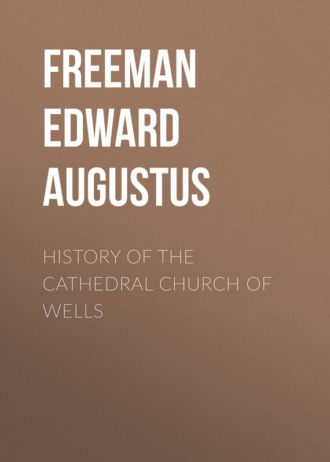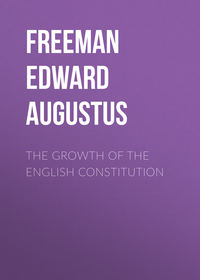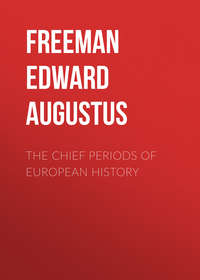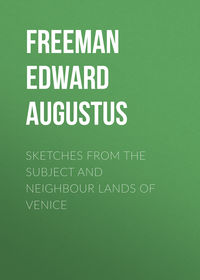 полная версия
полная версияHistory of the Cathedral Church of Wells
129
Some remarks of Mr. Dimock's on this subject will be found in the Proceedings of the Somersetshire Archæological and Natural History Society, lxii. 33.
130
At Hereford some of the Priest Vicars bore the title of Minor Canons. I do not know in what they differed from the rest of the body.
131
He seems not to have done anything for the fabric, though the north-west tower was still unfinished. But he gave tithes and other property to the Chapter for various purposes, one of which was keeping a common table; "ad mensam capitularem et alia onera in ecclesiâ Wellensi supportanda." Anglia Sacra, i. 570.
132
Anglia Sacra, i. 570. "Fecit etiam construi per executores suos in vico vocato la Mounterye mansiones pro xiv capellanis in dictâ ecclesiâ Wellensi indies celebrantibus." Godwin calls it "a colledge at Welles for fowerteene priests, at the ende of the lane now called Colledge-lane." On the history of this foundation, see Monasticon, viii. 1465.
133
In the account of the Deans in Anglia Sacra, i. 590, we read of him. "Vir impense literatus, postquam in utrâque academiâ Anglicâ bonis studiis operam dedisset, in Italiam profectus, Guarini Veronensis disciplinæ se tradidit."
134
See Mr. Parker in the Somersetshire Archæological Society's Proceedings, xi. 144 and xii. 25. Mr. Parker may be implicitly trusted on all architectural points, but he has quite failed to grasp the history of the foundation.
135
When I wrote this passage and an earlier passage in p. 23, I did not think how near my worst fears were to being accomplished. The organist's house at Wells, more strictly the house of the Informator Puerorum (see above, note 25), a house of the fifteenth century, stands to the south-west of the church, and was connected by some smaller buildings with the west wall of the cloister. The north gable, with a singularly elegant window of two lights, formed a striking object in crossing the Cathedral green, and held no mean place among the general group of buildings of which the church was the centre. For a long time past the building had been in a disgraceful state, and a munificent private offer to repair it was, for what reasons no man can guess, refused. Since that time, the buildings which connected the main body of the house with the cloister have been pulled down. This was a senseless act; for, though they had been much patched and mutilated, ancient portions still remained, and, in any case, their presence kept the house in its proper position as part of a whole. At last, on the night of April 12th, 1870, the ancient roof of the house, which still remained, fell in, damaging the gable and shattering the tracery of the window. How this came to pass there is no distinct evidence, but it is believed on the spot not to have been wholly accidental. Thus it is that our antiquities are daily perishing, because, while a taste for them and an appreciation of their value is daily spreading, those whose duty it is to preserve them are often those who have the least feeling for them. In the present case the damage which has been already done is the result of wilful neglect, but the complete destruction of the building would be a further act of wanton barbarism. I am by no means certain that the house could not even now be saved by a careful repair; but even if destruction has gone too far for that, what remains ought to be kept as a well-preserved ruin, and not to be swept away for any frivolous private purpose.
136
In this point of view the history of Wells is well worthy of the care of students of municipal history. The number of boroughs which arose under the shadow of abbeys, as at Saint Alban's and Bury Saint Edmund's (on which last see Mr. Green's papers, published in Macmillan's Magazine in the course of 1869), is not small; but of Bishops' boroughs there are not many. Durham and Salisbury (see above, p. 3) are the nearest examples, but their history is not exactly the same as that of Wells. Coventry, a still greater city, grew up under the shadow of an Abbey which became a Bishoprick.
137
Catalogue of Bishops, p. 307.
138
This was done in the year 1526 by authority of a bull of Pope Clement the Seventh; see, for instance, the account of Daventry Priory, in Northamptonshire, in the Monasticon, v. 176.
139
This was in 1414. A list of the houses suppressed is given in the Monasticon, viii. 1652. Among them was the Priory of Stoke Courcy, in our own county, which was a dependency of the Abbey of Lonley in Maine. Most of the estates of these monasteries went to the various foundations which grew up in the fifteenth century, as several of the Colleges at Oxford and Cambridge, the College of Eton, to which Stoke Courcy went, and Saint George's Chapel at Windsor. It should be noticed that this suppression took place under King Henry the Fifth and Archbishop Chicheley, than whom there certainly never was a more religious King or Primate in England. We have here the closest parallel to the disestablishment and disendowment of the Irish Church.
140
The suppressions under Henry the Eighth were the most complete contrasts to the suppressions under Henry the Fifth. The small portion of the monastic estates which went in any way to the public service, in the foundation of bishopricks and colleges and in providing for the defence of the coast, was a trifle compared with the boundless wealth which was squandered and gambled away among Henry's minions, to say nothing of the wanton and brutal desecration of churches and consecrated objects.
141
We should always distinguish between the two suppressions of Henry the Eighth's reign. The suppression of the lesser monasteries was done legally by Act of Parliament. The greater monasteries were suppressed by extorting from each Abbot and Convent an illegal surrender, which surrenders were afterwards confirmed by Act of Parliament. But Abbot Whiting never surrendered, so that the seizure of Glastonbury Abbey was simple robbery. The Abbot was of course really hanged for refusing to betray his trust. The nominal charge on which he was condemned by commissioners sent to "try and execute" him – the thing being thus arranged beforehand – was a ridiculous pretence of his having robbed the goods of the monastery, that is, having tried to save them from those who wished to rob them. This should be borne in mind, as I have seen it said over and over again that the Abbot was hanged for denying the King's supremacy, which the Abbot and Convent of Glastonbury, like other Abbots and Convents, had acknowledged long before.
142
See above, p. 46.
143
The list of Deans in Anglia Sacra, i. 590, says, "vir laicus, decanatum Wellensem ab anno 1537 pessimo exemplo tenuit. Capite plexus est 1540. 28. Julii."
144
See Hook's Lives of Archbishops, viii. 18.
145
Saint George's Chapel at Windsor was not suppressed; otherwise the few collegiate churches which still survive, including those of Ripon and Manchester, which have become cathedral, were refounded under Elizabeth and James the First. It was now that Beverley and several other great churches, as well as some smaller ones, like Stoke-sub-Hamdon in our own county, ceased to be collegiate.
146
The deed of pretended exchange is printed in the Monasticon, ii. 294. See also Godwin, p. 311; and Collinson's Somersetshire, iii. 395.
147
It was now that the Palace at Wells was restored to the Bishoprick. After the execution of Somerset it had passed to Sir John Gates, the destroyer of Stillington's Lady chapel, who was beheaded along with John Dudley, Duke of Northumberland, in 1553. He is the knight of the court, of whom Godwin speaks in his account of Bishop Burnell.
148
On the history of the so-called Priory, see the Monasticon, vii. 664.
149
See note 44.
150
See above, p. 50.
151
See Godwin, p. 311.
152
This strange document, dated in 1592, has, as far as I know, never been printed, and I have only seen an English translation. It first recites the doubts as to the legal position of the Chapter, arising out of the surrender made by Dean FitzWilliams in the time of Edward the Sixth, and the consequent establishment of a new Deanery by Act of Parliament. The Queen then founds the cathedral church anew, with all its dignities and prebends as they existed before. She then goes on to found "certain other dignities or offices," namely those of the Canons Residentiary. The names of the existing Residentiaries are recited, and the Dean and Canons Residentiary are constituted a corporation, by the title of the "Dean and Chapter of the Cathedral Church of Wells." To this newly-founded corporation the Queen grants the cathedral church, its appurtenances and movable goods, the Chapter-house and other lands and property, namely such as had been the common property of the Chapter. She then grants to them power to make, under certain conditions, statutes "for the good rule, government, and ordering of the Canons Residentiary and other Prebendaries in the said Cathedral Church." She then prescribes the number of Residentiaries, who are not to be fewer than six nor more than eight, and the manner of their election. They are to be chosen from the Prebendaries, a strong preference being given to the Dignitaries, including the Archdeacons, and the Dean having a right to a Residentiary's place if he chooses to claim it. The term of residence is fixed at four months at least yearly for a Dignitary being a Residentiary, and at three months at least for a Residentiary not being a Dignitary. These, it will be remembered, are exactly half the terms of residence fixed by Jocelin; see above, p. 90. The document then goes on to regulate the visitatorial powers of the Bishop, which are taken for granted. Then follow grants to the different Dignitaries and Prebendaries of their several corpses, and provision is made for the payment of certain customary sums to the fabric, the Vicars, and other purposes. Then come the names of the existing Prebendaries; and it is ordered that the Prebendaries "shall for ever be joined and combined with the aforesaid Dean and Chapter and their successors, to the ends, intents, and purposes following only, that is to say, the Prebendaries aforesaid, every of them and their successors, and the successors of every of them, shall have a stall in the choir of the Cathedral Church aforesaid, and that they and every of them shall have a place and voice in the Chapter of the said Cathedral Church only to elect a Bishop to the Episcopal See of Bath and Wells aforesaid, whenever it shall be needful." The Bishop's right of appointing to dignities and prebends is then renewed, saving only that the right of appointing to the Deanery is reserved to the Crown. The remaining provisions are merely formal.
The evident object of this document is to legalize a certain state of things which had gradually grown up by abuse. It had probably become customary for the non-resident Canons to be summoned to meetings of the Chapter only when a Bishop was to be elected. They were now formally deprived of their right to vote at other times. The Dean and Residentiaries, who had hitherto been simply certain of the Canons or Prebendaries selected for a certain purpose, were now themselves made the corporation, and the corporate style of Dean and Chapter was transferred to them. From this some grotesque results follow. The Chapter is first of all defined as a body of which the non-residentiary Canons are not members, and then the non-residentiary Canons are defined to be members of that body for one particular purpose; and the old formula, according to which each Canon had "vocem in capitulo et stallum in choro," is preserved, with the restriction that the voice is to be used only at the election of a Bishop. Then the practice by which the consent of the existing Residentiaries was needful for any Canon to keep valid residence is stiffened into an actual election by the existing Residentiaries. Lastly, the custom by which the Chapter always elected a nominee of the Crown to the Deanery is changed into an actual nomination of the Dean by the Crown. In all these cases the object is to legalize by royal authority an existing vicious practice.
It is curious to mark how, in the teeth of all this, some ancient customs are still retained as matters of form. The Canon, on his first appointment to his prebend, is solemnly installed in choir and chapter-house, but no such ceremony follows on his election to a residentiaryship, when he is simply put in possession of a house. This is of course because, under the older state of things, the Residentiaries were not a distinct body, but simply those among the Canons on whom the duty of residence fell on behalf of the whole. When a Canon began to reside, he was not invested with any new office; he therefore needed no new installation. By the Elizabethan Charter the Residentiaries were changed into holders of distinct dignities or offices, but no form of installation was prescribed, or could be prescribed, because the Residentiary retained the stall which he held before, and had no special stall as Residentiary. With the careless modern practice of Residentiaries or other Canons occupying stalls which belong to others of their brethren neither ancient order nor the Elizabethan Charter has anything to do.
It is worth noticing that in the list given in Collinson's Somersetshire, of the Chapter as it stood in his time, the Dignitaries and Prebendaries are all put in their proper order, with the words "Canon Residentiary" added to those who happened to be so. It is now the fashion to print the Residentiaries first in larger type, and the other Canons after them in smaller type. Such are the straws which show the way of the wind, and thus does oligarchy grow in all times and places.
153
The actual rights of the non-residentiary Canons, both at Wells and elsewhere, is a question of law, to be settled by a legal examination of various local statutes and general Acts of Parliament. The result would probably not be exactly the same in every church. But it is certain that, if our capitular bodies are to be of any use at all, they must be restored to their old broad basis. A body of forty or fifty clergymen, the pick of the diocese, partly resident at the cathedral, partly elsewhere, might be trusted to do many things which an oligarchy of four or five cannot be trusted to do. In the New Foundations the object would be gained by giving votes in Chapter to the Honorary Canons.
154
It would hardly be believed, except that the same havoc has been wrought in some other churches, that in an English cathedral church, in the year 1869, four stoves of incredible ugliness were set up, with chimneys driven through the vaulted roof! For the better display of one of them, part of Bishop Beckington's canopy, already moved from its place, was cut away; but, on the coming into residence of a Canon of better taste, it was put back. If the church wanted warming, the object might surely have been gained in some other way. In Bristol Cathedral there are stoves which are no disfigurement whatever.
155
They would, however, have a precedent in the famous scene between Archbishops Richard and Roger in the time of Henry the Second, which I will describe in the words of Godwin, p. 51. "At the time appointed the Legate came and tooke his place, and the Archbishop of Canterbury sate him downe next unto the Legate upon the right hand. After this in came Roger Archbishop of Yorke and would needes have displaced Canterbury to sit above him: that when the other would not suffer, he sate him downe in his lap. The other Bishops present, amased at this strange behavior of the Archbishop of Yorke, cried out all upon him; the Archbishop of Canterburies men by violence drew the other out of his ill chosen place, threw him downe, tare his robes almost from his backe, trode upon him, beate him, and used him so despitefully, as the Legate, whether for shame or for doubt what might happen to him selfe in such a tumult, got him out and went his way."
On the tomb of the doer of this havoc is written, with an unconscious sarcasm, "Multum ei debet ecclesia Wellensis." The words seem happily borrowed from Lucan's address to Nero:
"Multum Roma tamen debet civilibus armis,Quod tibi res acta est."
Dean Jenkyns, however, did not employ fire; the stoves were reserved for the next æra.
156
There is much in the details of the work at Llandaff which is fairly open to censure, but the principle of arrangement is thoroughly good throughout, and the general effect is admirable.
157
It is proposed to "restore," as it is called, the west front at a cost of many thousand pounds, while there are no signs of any movement towards getting rid of the crying abuses in the inside of the church. I believe there is no fear of the wanton destruction of any of the ancient work, or of any such absurdities as putting up new statues. Still it seems to me to be a strange putting of the cart before the horse to spend such a sum, or indeed to spend a single farthing, on purely ornamental work, while the arrangements of the inside are such that the church does not properly fulfil its first duty as a place of worship. When the nave of Wells Cathedral is again applied to its proper use, it will be time enough to think of canopies and carved work on the outside. And I am by no means clear that purely ornamental work of this kind ought to be restored at all. Anything that is really needed for the safety of the fabric should be done with all boldness, and all really essential features should be made good. If the western towers were likely to fall, it would be a matter of duty to support or to rebuild them, as the case might call for. And as the doors and windows are essential parts of the building, I should without scruple restore their decayed bases, mouldings, and other portions. But as to the purely ornamental work, the statues and their canopies, it seems to me that their value comes wholly from their being genuine parts of the original work, and that any modern repair is out of place. I should take every means to preserve them and keep them in their places; but, if they fall or crumble away, I should not replace them. I therefore greatly regret, on every ground, to see a work undertaken which can hardly fail to have the effect of putting off the real restoration of the church of Wells for many a day.
158
If the screen is, which I do not believe that it is, of any constructive use in keeping up the piers of the eastern arch of the tower, the obvious thing is to build a fourth Saint Andrew's cross in the eastern arch as in the other three.







